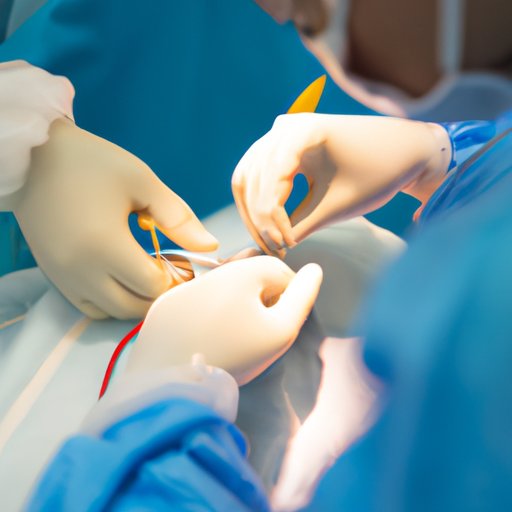Introduction
Cauterizing, also known as cautery, is a process of using either heat, electricity, or a chemical agent to stop bleeding or remove tissue.
Typically used in medical and surgical settings, cauterizing can be uncomfortable, even painful, but it is still a very effective way of controlling bleeding and promoting healing.
This article explores the science behind cauterizing, the different types of cauterization techniques, as well as its potential benefits and risks.
The Science Behind Cauterizing: How It Stops Bleeding and Promotes Healing
When the skin or flesh is cut, the body’s natural response is to send blood to the affected area in order to help repair the damage. While this process helps with healing, it can also lead to significant blood loss.
Cauterizing essentially works by applying heat, electricity, or a chemical agent to the wound, which helps to coagulate the blood and stop the bleeding. This process is critical in preventing excessive blood loss in emergency situations.
Moreover, the heat generated from cauterizing can actually help to promote healing in the wound. This is because it can stimulate the production of collagen, a protein that plays a vital role in the body’s healing process.
Cauterizing: A Painful but Effective Method to Control Bleeding
The cauterizing process can be overwhelming and even painful in some instances. However, when it comes to controlling bleeding, it is still one of the most effective methods available.
The pain associated with cauterizing is usually caused by the heat applied to the tissue, which also causes nerve endings to be stimulated. In addition, some people might experience pain due to the smoke or aroma that results from using a cautery pen.
To minimize the discomfort, pain management techniques, such as the use of ice or local anesthesia, can be incorporated during the cauterizing process. It is also important for the healthcare provider to communicate and prepare the patient for the sensations they might experience during the procedure.
Exploring the Various Types of Cauterization Techniques and Their Uses
There are different types of cauterization techniques, with each technique serving a specific function in wound care.
The most common is electrocautery, which uses an electrical current to heat and coagulate blood vessels. In contrast, chemical cautery uses a chemical agent to stop bleeding, such as silver nitrate. Laser cautery is a newer technique that uses a concentrated beam of light to effectively coagulate blood and remove tissue.
The type of cauterization technique used will depend on the situation, the type of wound, and the equipment available.
Electrocautery is usually preferred for small procedures, while chemical cautery is typically used for specific types of wounds, such as nosebleeds. Laser cautery is usually reserved for more specialized procedures, such as during eye surgery.
While each technique has its advantages and disadvantages, the main goal is to stop bleeding while minimizing pain and discomfort for the patient.
Cauterizing: Understanding the Potential Risks and Benefits
Cauterizing, like any other procedure, comes with its potential risks and benefits.
The primary risk associated with cauterizing is the potential for tissue damage, infection, and scarring. In some cases, cauterizing can also result in nerve damage, malfunction, or even paralysis in specific cases.
Despite the risks, some people might opt for cauterizing because of its potential benefits. It is a quick and effective way to stop bleeding, which can mean the difference between life and death in emergency situations.
Cauterizing also comes with the benefit of reduced recovery time, as there is less post-operative bleeding. In cases of chronic bleeding, cauterizing can effectively stop the bleeding and provide relief to patients who have been suffering for a long time.
Compared to other methods of controlling bleeding, such as sutures or staples, cauterizing also tends to be faster, requires less equipment, and results in less discomfort for the patient.
Cauterization in History: From Ancient Practices to Modern Medical Applications
Cauterization is not a new practice, and has been used for centuries to stop bleeding and remove tissue. In ancient times, it was often used as a form of punishment and torture.
However, as our understanding of medicine and wound care grew, cauterization has evolved into a reliable medical technique. Today, it is used in a variety of specialties, such as dermatology, ophthalmology, and general surgery.
Conclusion
Cauterizing is a valuable technique for controlling bleeding and promoting healing. While it can be painful and carries potential risks, it is still a very effective method.
With advances in technology and medical practices, cauterizing has also evolved over time, resulting in more efficient and effective procedures. If you are considering cauterizing, it is important to discuss your options with your healthcare provider to determine the best approach for your specific situation.
(Note: Is this article not meeting your expectations? Do you have knowledge or insights to share? Unlock new opportunities and expand your reach by joining our authors team. Click Registration to join us and share your expertise with our readers.)
